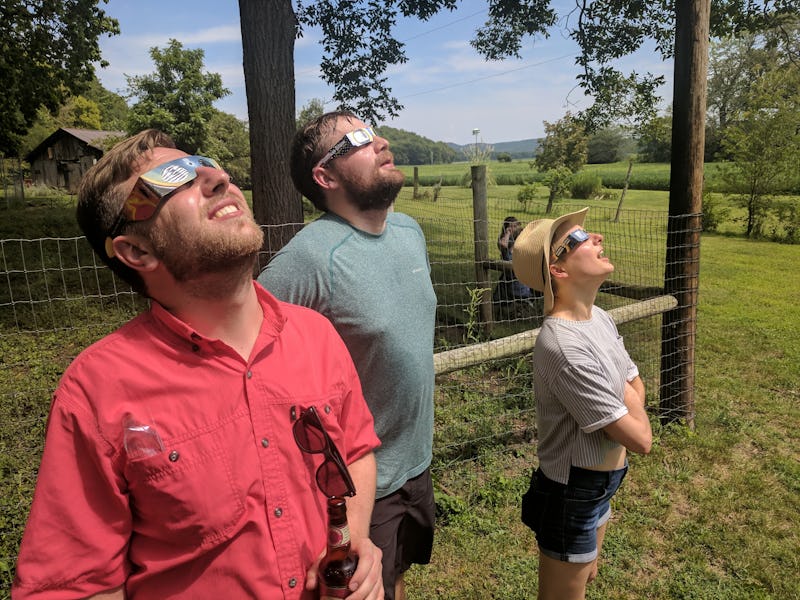For a bit more than two minutes, on a small small farm in Eureka, Missouri, we entered a different universe, stood on a strange planet, and stared up at a completely alien sky.
The photos don’t prepare you. Even though social media has mobilized millions of people all over the United States to find the best possible view of the event, the images you’ve see images you’ve seen don’t communicate what the sky really looks like from the path of totality.
The science is pretty simple; Periodically, our moon slips between our planet and our star, and casts a narrow shadow across the surface. The sun’s corona, usually invisible to the naked eye, becomes the brightest light in the sky — a ring of yellow-blue fire encircling Luna’s dark pupil.
This happens every couple years somewhere on Earth, but because the Earth is mostly water, it’s rare for most landbound humans to view a partial eclipse, much less a total one. No path of totality has crossed the greater St. Louis region since 1442
A farm just a few miles from the path of totality served as our headquarters for the day.
My partner, Meghan, and I crossed the country to see this. We spent the weekend, along with a small pack of college friends, at her parent’s house in the suburbs of St. Louis. Their house was on the edge of the path of totality, where it would have lasted seconds, not minutes. So we braved the threatened traffic, loaded up a caravan of cars, and drove to the family farm of Sally and Todd Brown — two of Meghan’s father’s friends lucky enough to own a wide-open plot of land just a few miles from the centerline. The traffic never materialized, and the whole adventure was worth the hassle.
At a certain point though, things got weird. No photograph can convey the weird light of a waxing sliver sun at high noon. It tricks your eyes and mind. The shapes of shadows on the land and people’s faces still match any midday summer. Colors deepen and remain saturated, completely unlike a dim cloudy day. The sun, unfiltered, is still a blinding blaze of light in the sky — too harsh to look at directly. But the whole world looks dark and wrong. The closest analogies I’ve come up with is an under-exposed photograph, or the look of high noon through dark grey sunglasses.
Friends look up as totality occurs. For a moment, we were all quiet and watching the sun and moon.
Neither of those is quite right though.
Our little crew marveled at this strange effect, standing in the suddenly cool light of the sun as the sliver shrank to a fingernail. That’s when everything in the world seemed to turn into a camera obscura. The leaves of trees, the narrow gaps in our fingers, and the holes in Meghan’s straw hat all cast little banana-sunss across the earth and our skin. The posse of a dozen-odd chickens and guinea fowl, which Todd had turned loose from their pens so we could watch their behavior, ceased cooing and clucking and stood very still.
As the almost cloudless day darkened still further in the last minutes before the eclipse, we all gathered — without any instruction — into a small knot on the open grass, calling out each new demarcation even as we all stared up together through our glasses. The closer the moon’s shadow got to the sun’s far edge, the faster it seemed to move. With under a minute to go, the westernmost patch of sky turned a dark, saturated shade of blue, like a blot of watercolor bursting through the firmament.
Then, in a last rush of disappearing light, the sliver shrank to a point, winked out, and we entered the totality. You’ve likely heard the parts of the scene described before: night-bugs waking up and calling out to each other in the ecstasy of their early-afternoon orgy, a sunset on every horizon, fading toward an inky, navy-tinged center of the sky, wind and silence. And hanging above our heads, the thing itself. God’s eye, a portal to another place, a hole in the middle of everything, ringed in fire.
For two minutes, the moon was a dark disk. The corona, far vaster than the celestial bodies themselves, arced away from it. We stared up, shouting and then shushing each other to listen to the night noises. When the first blinding beads of sunlight appeared on the far side of the moon, the chickens had barely returned to the edge of their coop. Soon enough, they were clucking at the new day.
I’m writing this from a car on the way back to St. Louis. This was without question among the most singular and astonishing things I’ve experienced in my lifetime. Standing under an eclipse, you become suddenly aware of yourself as a small creature stuck the surface of one ball of rock hurtling through a wild, spinning dance with its cold, hot, and massive neighbors. I think this article is evidence that it’s difficult to describe the cumulative effect of all those parts without resorting to melodrama and cliche.
The next American total eclipse is coming in 2024. You should figure out a way to see it.
